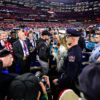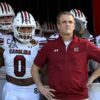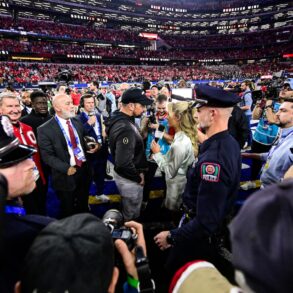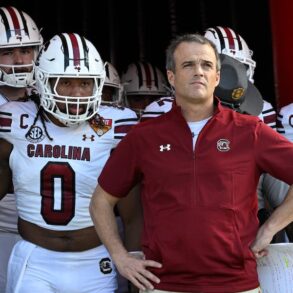Megan Way P’26 watches a lot of college football games. Her son, Joe, just finished his first season playing for Southern Connecticut State University, a Division II program. He’s an offensive lineman. “Joe loves absolutely everything about playing football,” says Way, an associate professor of economics at Babson.
Way and her husband attended all of Joe’s games, both home and away. She admits that watching from the stands comes with some worry. “I’m a mom, so I pray during most games that all the young men out on the field finish the game in one piece,” she says. “I hate seeing the injuries, but I love seeing the joy after a great play.”
Way’s interest in college football, however, extends beyond her son and his team. As a labor economist, she’s concerned by the human costs of the game, and questions about college football frequently pop up in her Economics of the Labor Market class. “I am fascinated by any activity where people willingly put their bodies on the line,” she says, “and really gamble each game with having a career-ending injury.”
As the college football playoff nears its end, with Ohio State and Notre Dame set to square off in the national championship game this coming Monday, Way reflects on the state of the sport. In recent years, big-time, Division I college football has undergone transformational changes.
Radical conference realignments have upended traditional rivalries and travel itineraries; the transfer portal has allowed numerous players to switch teams every year; and name, image, and likeness (NIL) deals have brought players big paydays. Even the playoff itself has seen a change, expanding to a dozen teams this year.
“The market forces affecting college football are too many to count, and they are pulling it toward professionalization,” Way says. Colleges, along with advertisers, sponsors, and the media networks broadcasting the games, all have one thing in common. “Everyone wants to make money off these student-athletes,” she says.
Conference Realignments

When thinking about the state of college football, Way tries to understand what its transformation means for athletes. Consider, for instance, the rampant switching of teams to new conferences, often to areas far from campus.
To cite just one example, the Big Ten Conference, which is primarily based in the Midwest, has added four new West Coast teams: Washington, Oregon, USC, and UCLA. That can make for a lot of traveling for games, not just for football players, but for athletes playing less visible sports.
“It’s hard for the football players when they are in a conference that has teams that are really far away geographically, but at least the change is being made with their sport as the beneficiary,” Way says. “If it improves their visibility, their rankings, and they can get an NIL deal, they see some benefit.”
But what of athletes who play softball or volleyball or swimming? “The problem is with all the other sports that get dragged into these conference changes, particularly when the travel increases,” Way says. “The conference realignments are not necessarily being made to improve the situations of athletes in those sports.”
NIL Deals
In regards to NIL deals, the idea that student-athletes should be paid to play sports may feel nontraditional and unconventional, but again, Way looks at this change from the players’ point of view. How much players can make depends on various factors, but the starting offensive and defensive lineup for a championship-contending team may earn more than a combined $10 million.
“I am very much in favor of NIL deals. With all the money being made on college sports, student-athletes should be able to profit off their talent and their contributions, particularly given the risks they take,” Way says. “Career-ending injuries happen frequently, so today may be the only day that these athletes can make money from their sport.”
Sports are a frequent topic in Way’s Economics of the Labor Market class, and with the high-profile nature of collegiate athletics, the question of whether student-athletes should be considered employees is one that comes up often. “There are a lot of other markets—the gig economy in particular—where people are working for an organization but not given the benefits of being employees,” Way says. “This is a great and complex question to consider in class.”
The Transfer Portal
Way is also in favor of another major trend reshaping college football, that of scores of players every year entering the transfer portal, essentially a database of all student-athletes interested in changing schools. At the highest level of college football, more than a quarter of players on scholarships transferred after the 2023 season.
The reasons players transfer are varied, Way says, and shouldn’t be viewed as frivolous. “Not all players who enter the portal are doing it to get to a better team,” she says. “They may just want to transfer schools like so many other college students, to get into a different academic environment or live closer to home. Others have future athletic careers in mind, are looking for better scholarships, or need a better coach for their development.”
“I am fascinated by any activity where people willingly put their bodies on the line and really gamble each game with having a career-ending injury.”
Megan Way P’26, associate professor of economics at Babson
All this transferring can create a chaotic environment for the sport, and players entering the portal face some risk, as their old school could potentially take away their scholarships if they decide ultimately not to transfer.
That said, there is also opportunity. Way’s son knows a couple of players from his team who entered the portal last month, with at least one so far receiving a D1 offer. “I asked Joe how he felt about that, and he was really happy for the guy,” Way says. “He will miss him as a teammate, but D1 is a great opportunity for him.”
Posted in Insights
Related Stories
This post was originally published on this site be sure to check out more of their content.






